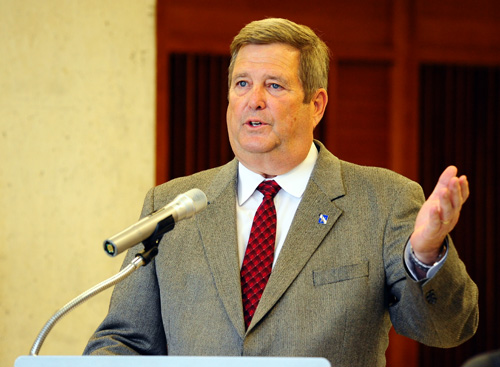
Kirkwood President Mick Starcevich discusses the community college’s nearly $1 billion economic impact in the state of Iowa during his remarks at a May 19 anniversary reception. PHOTO/Joe Photo
By Dave DeWitte
dave@corridorbusiness.com
Turning 50 is a good time for reflection, and that even goes for community colleges.
Kirkwood Community College recently commissioned an economic impact study showing the difference it’s made in the state of Iowa, which, judging from the results, is huge.
The study found that between 2013-2014, Kirkwood added $973.3 million in income to the economy, including $819.4 million in added income resulting from former students employed in the state’s workforce, $92.2 million in college payroll and expenses, and $60.1 million spent by students.
The years upon which the study was based weren’t even a high-water mark for Kirkwood. Enrollment spiked due to high levels of workforce dislocation following the recession in 2008-2009, sending enrollment to a peak of 20,000 in two years. It has since fallen to a more normal – and sustainable – 15,000 students spread among 12 campuses.
The college has developed a reputation as a partner to Corridor businesses, helping them meet both specialized and general training needs, Kirkwood President Mick Starcevich told the CBJ.
“We did training in over 300 businesses this year to improve the skills of the employees,” he said, adding that more efficient employees means greater job retention, and more successful businesses.
The study by Economic Modeling Specialists of Moscow, Idaho, estimated the college provides a return of $3.70 on every $1 spent by students and by taxpayers.
“We need to be more aggressive on how we show our value,” Mr. Starcevich said.
Telling that story could have a big impact on how Kirkwood fares in the next 50 years or more. The college received no increase in financial support from the state in fiscal year 2016, and a 1.5 percent increase in 2017.
If that low rate of change continues, the college could be forced to take steps such as cutting back services or raising tuition, currently among the lowest in the state. Instead, the college would like to position itself for the challenges of the rapidly changing educational environment and workforce needs, Mr. Starcevich said.
“The biggest change in the next five years will be in how we deliver education,” he said, adding that the college needs to provide more experiential learning experiences. “Students are no longer willing to listen to a talking head. If we aren’t going to change, we’re going to lose them.”
The college is also focusing on improving its online learning opportunities for the segment of the student population that prefers to learn that way, and helping students earn while they learn.
“One of our bigger efforts will be apprenticeships, and trying to make them paid apprenticeships,” Mr. Starcevich said. The model allows students to learn and gain job experience, but it can also help them pay for their college education and thereby reduce college debt, he noted.
Kirkwood now has more than 70,000 alumni, thanks in part to one of the highest graduation rates of any community college in the nation. Iowa Lt. Gov. Kim Reynolds recounted some of the college’s history during a reception held for supporters and alumni on May 19 at Linn Hall on the Cedar Rapids campus. She made particular note of the transformational nature of dual enrollment, which began in 1973. That was when the college began accepting high school students to take credit classes paid for by their high schools.
Some 5,000 high school students took Kirkwood classes last year at no cost to their parents, who saved $4.4 million. Many are leaving high school with a full semester of college credit, and one student will be graduating with a degree from Kirkwood this spring in the same month they graduate from high school.
Ms. Reynolds also praised Kirkwood’s role in STEM (science, technology, engineering and math) education, calling its STEM Career Academies at the college’s new regional center at the University of Iowa “an example of how to give students a globally competitive education.”
She said Kirkwood has an important role in the Future Ready Iowa Program, which aims to make sure 70 percent of Iowans in the workforce have education or training beyond high school by 2025.
“All of this underscores the vision, leadership and dedication of Kirkwood and its larger community,” Ms. Reynolds said.




